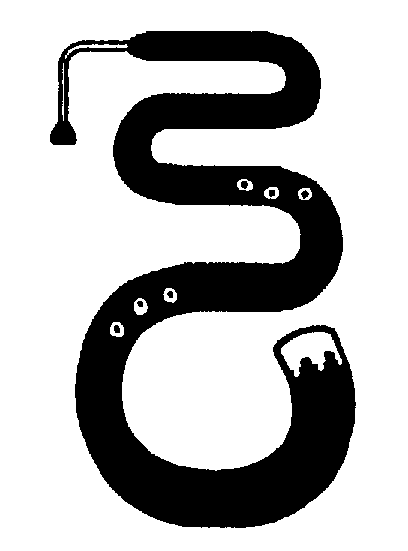 |
To the left is a simple profile of a French "Church" style
Serpent.
To the right is a profile of an English "Military" style Serpent. Note
the somewhat tighter bends in the Military style, making the metal rods
between bends necessary. The Military instrument also has more metal
bands
and other reinforcements. For actual photos of these instruments, see
the
links below. Note that this page is designed for quick loading, and all higher resolution and/or color pictures are via links. |
 |
|
|
|
|
|
|
|
|
 |
To the left is a profile of a wooden Basshorn, one of the
later variations
on the Serpent. It was identical acoustically to the Serpent, but had a
simpler shape. Basshorns were also made of metal; see the link to the
upper
right. To the right is a profile of another Serpent variation, the
Russian
Bassoon; basically a more flamboyant style of basshorn, it is not a
bassoon,
and has nothing to do with Russia.
Another variant, similar to the Basshorn and the Russian bassoon, was the Serpent Forveille (Fore-vay). |
 |
 |
To the left is a picture of an Ophicleide, which eventually replaced the Serpent, and was itself replaced by the tuba. To the right is a picture of an Ophimonocleide, which although similar in appearance and name to the Ophicleide, is actually a kind of basshorn with some Ophicleide-like enhancements; its bell and bocal were brass, but the rest of the instrument was made from wood. The 'Ophi' in both names means 'Serpent'. |
 |
|
Click here to see whimsical drawing of an Ophicleide (courtesy of illustrator Jackie Gaff, employee of the Trader Joe's store in Burlington, Massachusetts photo taken by Doug Yeo) Click here to see another photo of a 'Monstre' (contrabass Ophicleide) -1830 French example, the oldest existing historical original Monstre - photo courtesy of the Muscial Instrument Museum, Brussels |
-ca. 1850 German example, by Andreas Barth, Munich - instrument is on display at the Deutsches Museum, Munich, Germany (distorted photo taken through glass display case) |
Click here to see yet another 'Monstre' (contrabass Ophicleide) -ca. 1850 German example, by George Saurle (Jr.) - photo courtesy of the Karl Marx Univeristy Music Museum, Leipzig, Germany |
 |
To the left is a picture of a Baritone, which is shown only for comparison to the Euphonium to the right. The Serpent was replaced by the Ophicleide, which was replaced by the tuba. The Euphonium is a tenor tuba, and has the same pitch range as the Serpent and Ophicleide. Note that the Baritone is in a somewhat different branch of the brass family, since its bore is not conical; it is really more like a member of the trumpet family. The bass tuba is shown to the lower left. |
 |
 |
To the left is a picture of a Tuba, more accurately called
the Bass
tuba. Note that the way instruments were named in past centuries is not
the same as the system used more recently. During the time the Serpent
and Ophicleide were the main low-brass instruments, they were the bass
members of the brass family. Later on, contrabass brasses were
invented,
and the modern tuba is an example. However, even though the bass tuba
is
technically a contrabass instrument, we think of it as a bass, making
the
Euphonium a tenor even though it would have been thought of as a bass
in
past centuries. So, the Serpent, Ophicleide and Euphonium all play the
same pitch range, in spite of the former instruments being basses and
the
latter instrument being a tenor.
To the right is a picture of a Keyed Bugle, the smallest member of the family that includes the Ophicleide. It has the pitch range of a trumpet and is similar in sound to a flugelhorn. |
 |
 |
To the left is a drawing, taken from a photo, of Andrew van der Beek playing the original contrabass Serpent, or "Anaconda". Note that there are 10 keys on this anaconda, and also that they are smaller towards the mouthpiece and progressively larger towards the bell, are spaced more evenly along the length of the bore, and except for the largest key they open when their keys are pressed instead of closing. This makes the instrument play more like the "Monstre" contrabass ophicleide than a contrabass Serpent. To the right is a link to a photo of a contrabass Serpent that has playing characteristics just like other Serpents. |
See links to the Edinburgh University museum for a color photo of the original Anaconda at left Click
here to see
a photo of Doug Yeo |